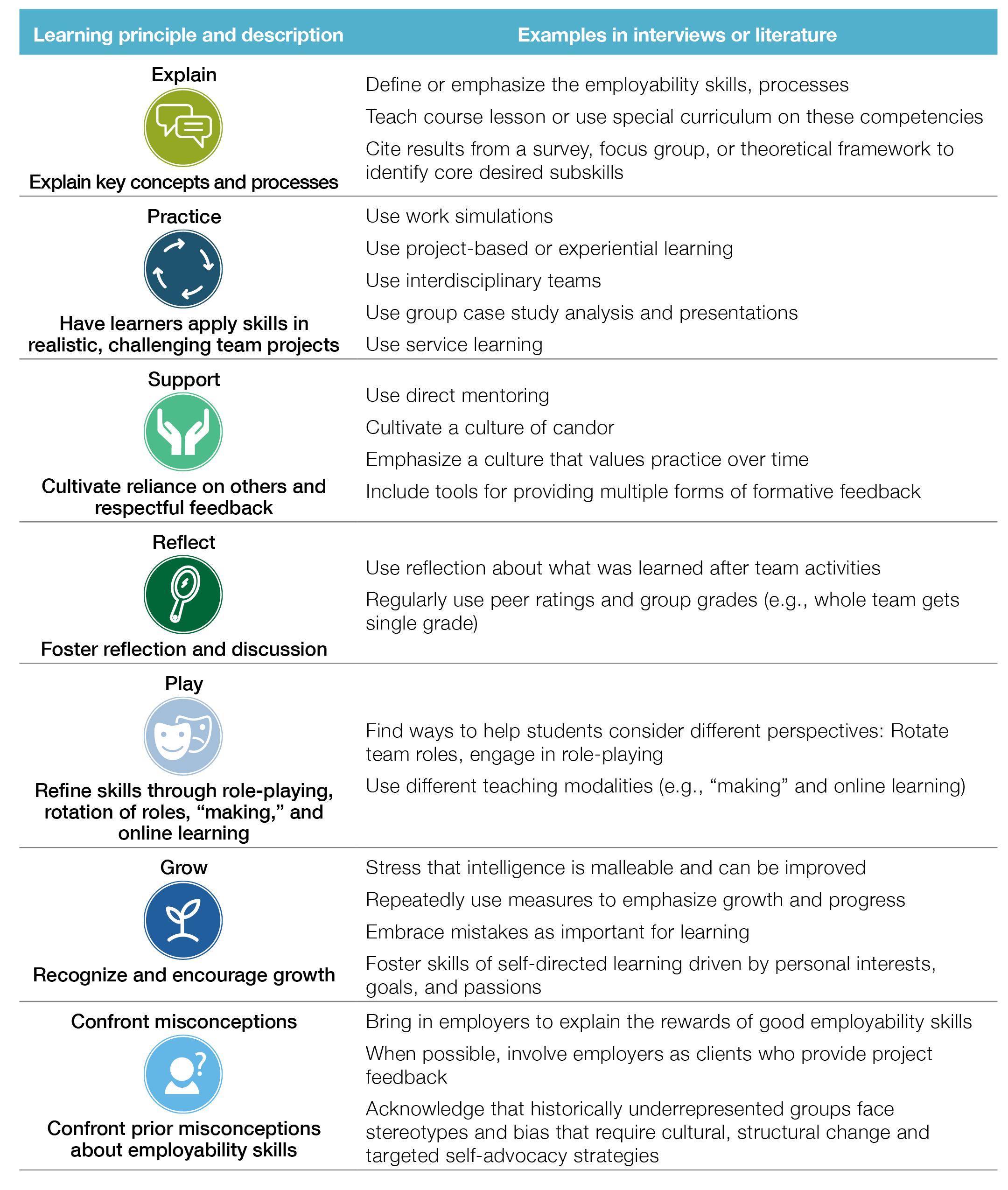
by Louise Yarnall and Hannah Kelly
November 9, 2021
Over the past 2 decades, the United States has seen enormous growth in the science, technology, engineering, and mathematics (STEM) fields. This growth has been particularly strong for high skill technician jobs in technology and computer science, which offer a promising path to the middle class for many Americans.1 To succeed in their work, skilled technicians need a wide range of employability skills, such as teamwork and communication, in addition to technical skills.2 However, technician employers have increasingly voiced their dissatisfaction with new hires’ underperformance in these “softer” skills.3 They targeted their concerns toward America’s community college technician educators who play a central role in preparing the nation’s technical workforce.
In response, some community college technician educators began developing innovative programs to develop students’ employability skills. Many of these innovators quickly produced results that won over their employer partners.4 However, the principles and techniques they used to achieve success were not widely studied or shared even as thousands of technician educators struggled or failed to develop their students’ employability skills, reinforcing the barriers that many community college students face in securing access to STEM technician careers.5
To address this problem, SRI Education researcher Louise Yarnall and her colleagues compiled insights from 2 decades of postsecondary innovation into employability skills instruction in STEM courses. Through a 2-year grant from the National Science Foundation, her team conducted a systematic review of 273 research articles from 4-year STEM educators in computer science and engineering and 40 structured interviews across 14 states with 2-year STEM educators, their employer partners, and a small sample of 2-year program graduates. Here’s what they found.
What are the key employability skills for high-skill technicians?
Employability skills or competencies are transferable skills that employees can take from one workplace to another. They typically include communication, teamwork, positive orientation to lifelong learning, adaptability to workplace expectations, and an understanding of business fundamentals (for example, being aware of the mission of a business and the role that one’s job plays within an organization).6 These skills have not traditionally been part of community college technical preparation curricula for several reasons: resistant attitudes in the technician education culture, self-doubt, and discomfort around teaching non-technical knowledge and skills, and an overwhelming list of potential skills to address.7 Indeed, the sheer number of employability frameworks and skills can be off-putting: Yarnall and her colleagues reviewed more than a dozen employability skill frameworks including 61 different skills. Fortunately, they also homed in on five high-priority employability skills for the technician field.
Five High Priority Employability Skills for Technicians

The high-priority employability skills are mutually reinforcing and complementary. For example, the personal quality of adapting to workplace expectations, which includes elements of reliability and conscientiousness, is often mentioned as a foundational component of teamwork and collaboration.
Research points to clear principles for developing employability skills
So, what can institutions and technician educators do to improve students’ employability skills? Through the systematic analysis of both the research literature and interview data, Yarnall and her colleagues identified seven learning principles that innovators have used to cultivate employability skills.
Seven Learning Principles for Developing Employability Skills

Further, the project compiled resources educators can use to integrate these principles into their classrooms to prepare future STEM technicians for a workforce that values both their specialized knowledge and skills and their ability to be communicative, collaborative, forward-thinking team members. You can find more than 200 examples of teaching techniques used in secondary school, college, and the workplace on the searchable project website, which includes a free practitioner-oriented handbook and two recorded webinars.
Footnotes
2Baruch, Y., & Bozionelos, N. (2011). Career issues. In S. Zedeck (Ed.), American Psychological Association handbook of industrial and organizational psychology (pp. 67–114). Washington, DC: American Psychological Association.
Levy, F., & Murnane, R. J. (2004). The new division of labor: How computers are creating the next job market. Princeton, NJ: Princeton University Press.
Merriam, S. B., Caffarella, R. S., & Baumgartner, L. M. (2007). Learning in adulthood: A comprehensive guide. San Francisco, CA: John Wiley & Sons.
3Lim, Y. M., Lee, T. H., Yap, C. S., & Ling, C. C. (2016). Employability skills, personal qualities, and early employment problems of entry-level auditors: Perspectives from employers, lecturers, auditors, and students. Journal of Education for Business, 91(4), 185-192.
McMurtrey, M. E., Downey, J. P., Zeltmann, S. M., & Friedman, W. H. (2008). Critical skill sets of entry-level IT professionals: An empirical examination of perceptions from field personnel. Journal of Information Technology Education: Research, 7(1), 101-120.
4Mindham, J., & Schultz, D. (2019). The impact of youth apprenticeship and employability skills programs on career & technical education concentrator-completer post graduation outcomes. Career and Technical Education Research, 44(3), 3-14.
5Hora, M. T., Benbow, R. J., & Smolarek, B. B. (2018). Re-thinking soft skills and student employability: A new paradigm for undergraduate education. Change: The Magazine of Higher Learning, 50(6), 30–37. doi:10.1080/00091383.2018.1540819
6U.S. Department of Labor. (2017). Building Blocks for Competency Models – Foundational Competencies. Washington, DC: U.S. Department of Labor. https://www.careeronestop.org/CompetencyModel/competency-models/pyramid-download.aspx?industry=building-blocks
7Mozilla Foundation. (2015). Mozilla 21C skills and competency metagrid. Mountain View, CA: Author. Retrieved from https://drive.google.com/file/d/0B9qOTaXg3UmRdXBDOEttSllpNFU/view
Topics: Access and equity Adult learners Career and technical education Community colleges Employability skills Integrated college and career pathway approaches STEM and computer science pathways Transition to postsecondary Work-based learning
